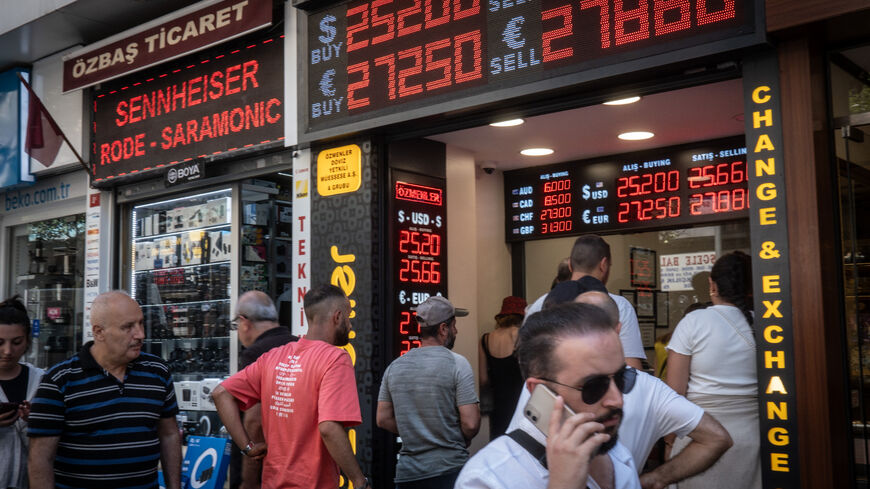ISTANBUL — The sizeable but smaller-than-expected rate hike by Turkey’s Central Bank has come as a relief for banks, which had feared the fallout of a much more aggressive and abrupt increase under a new economic leadership pledging a return to “rational” management of the economy.
In a departure from President Recep Tayyip Erdogan’s unorthodox policy of cutting rates despite soaring inflation, the central bank raised its policy rate by 650 basis points to 15% on Thursday. The move came after Erdogan appointed a new governor, Hafize Gaye Erkan, and a new treasury and finance minister, Mehmet Simsek, in a bid to regain investor confidence and revive the flow of foreign capital to ease Turkey’s foreign exchange crunch. The hike, however, was smaller than most forecasts, with the bank’s policy rate still well below the nearly 40% inflation rate.
In announcing the decision, the central bank signaled a gradualist approach to further hikes down the road. “Monetary tightening will be further strengthened as much as needed in a timely and gradual manner until a significant improvement in the inflation outlook is achieved,” the statement said.
The rate had been widely expected to be raised to 20% or more, with Goldman Sachs forecasting a drastic move to 40%.
The relatively soft transition to monetary tightening is believed to be dictated by political considerations, among others. After winning a third presidential term last month, Erdogan faces local elections in March 2024, hoping to wrestle Istanbul and other big cities back from the opposition. Hence, he needs to avoid a too-harsh economic climate ahead of the polls.
Many had feared that banks, in particular, would struggle to adapt to a very drastic increase, with the potential ripples exacting a toll on the entire economy.
Banks benefitted greatly from the rate-cutting drive, which had brought the central bank’s policy rate to 8.5% in February from 19% in September 2021 at the expense of sinking the Turkish lira and fanning inflation. According to official data, the banking sector profited 432 billion liras ($17 billion) last year, with net profits amounting to 50% of their average equity capital. The sector’s net profits reached 145 billion liras ($5.7 billion) in the first four months of 2023.
The central bank loaned banks 1.4 trillion liras ($55 billion ) — 800 billion liras ($31.7 billion) in the form of swaps and 600 billion liras ($23.4 billion) in the form of repos — at the very low cost of 8.5%. Hypothetically, had the central bank raised its policy rate to 25%, the borrowing cost of the same sum for banks would have increased by 16.5 percentage points or 231 billion liras (over $9 billion), the equivalent of nearly 54% of their profits last year. With a 6.5-point hike, that increase would be limited to 91 billion liras ($3.6 billion).
Banks have also been uneasy over the low-yielding government bonds they have been forced to hold as part of regulations to curb dollarization. The penalty-like measures have required banks to buy government bonds with 10% yields for failing to keep lira deposits at certain levels.
With a more aggressive increase of the policy rate, the low-yielding government bonds could have threatened to upend the banks’ balance sheets. To ease this problem, the central bank is likely to take those bonds back and replace them with new ones. Such a measure is expected to relieve banks of a burden of at least 200 billion liras (some $8 billion).
In sum, market watchers believe that the relatively moderate rate hike will help banks as well as companies to acclimatize to the new era. Having increased their profitability amid runaway inflation, some companies had already prepared themselves for a rise in financing expenses. Yet many small- and medium-sized companies with limited equity capital faced dire straits in the event of a very drastic rate hike. Now, they, too, have been allowed room to adapt.
The same goes for consumers using loans to buy homes and cars or meet other personal needs. Household indebtedness in terms of such consumer loans is not very high, which will facilitate the adaptation.
Non-performing loans in the banking sector stand at about 2% officially. Yet there is a large stock of “restructured” loans whose repayment periods have been extended. The amount of such loans is not officially released, but they are described as a major problem at banks, especially public banks, where lending is often prone to political influences. This soft belly of the banking sector is seen as another reason for a gradual transition to a “rational” economic management.
The central bank is likely to deliver another rate hike at its next meeting on July 20. The course of inflation is expected to affect the magnitude of the hike, while rising foreign exchange prices continue to bear on inflation.
The smaller-than-expected rate hike fueled the depreciation of the lira. The currency tumbled past 25 versus the dollar on Friday, losing 7% of its value in two days. Whether the authorities will intervene to prop up the lira remains to be seen, but the increase in the dollar price — about 30% since the May 14 first round of elections — bodes fresh inflation woes for the import-reliant Turkish economy. Fears that annual inflation could jump back to somewhere between 50% and 60% are not unfounded.








